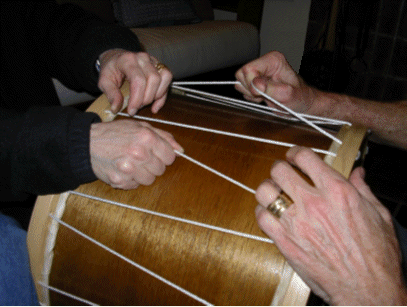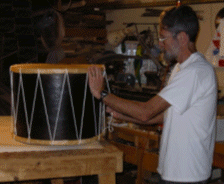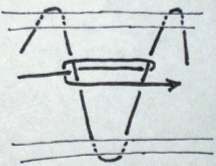General caveats
Tupans with goat skin heads are dynamic instruments and sensitive to all sorts of influences. Relative humidity changes affect the heads a great deal. Goat skin is very strong but it can split. So a few points to remember.
- Always loosen the tightening cord (slide it towards the middle of the drum shell) after playing.
- Never leave the head exposed to sunlight.
- Don't leave it anywhere where critters can get at it. Dogs love to chew goat skin as do mice. Even cats will lick goat skin.
- Don't leave it outside at night. The drastic changes in humidity will raise havoc with the heads.
- If you're going to much dryer climates or flying on an airplane, take the tightening cord off and loosen the zigzag cords that hold the heads on.
Tightening the heads

Six months or less after you get a new drum, you'll notice that the tightening rope is up against the rim and you can't get the head tight. It's time to take some slack out of the zigzag rope that hold the heads on. Take off the tightening rope. If it's one of mine, pay attention to the knot that is around each pair of ropes, since it is a very good one. I'd suggest you undo one and then try to retie it. The directions and a diagram are below in the tying the tightening cord section if you need a reference.
Now untie one end of the zigzag rope. It's usually pretty obvious which one to untie, since the wrong end usually has a loop in it that is slip-knotted around some piece of hardware. If it isn't obvious, pick the one that looks easiest to untie.
Work some slack all the way to the other end. This is so you'll have enough slack to grab in the tighten process.

Tightening is a two-person job. Actually one person can do it - that's what I'm doing in the second picture, but it takes more skill, a high work surface, and tough hands. Note: if you try the one-person method, put an old towel under the down face to protect it from any rough spots on the surface.
Get a friend who doesn't mind getting sweaty and maybe getting some blisters to help. Both of you should have a leather glove on your strong hand. You may also want to have some athletic tape to wrap fingers that are taking a beating.
Remove any sharp objects from your front, like metal belt buckles or pens in your shirt pocket, since you'll be pulling the drum against your front and you don't want to damage the head. Now sit facing each other on the floor with one drum face towards each of you.
Starting at the tied end, the person on the side it points towards pulls the rope towards themselves until it makes a fairly high musical note when plucked. Now they hold the rope (a finger firmly on the rope where the rope goes through the head or rim is usually enough friction) while the person on the other side pulls the rope. Proceed around the drum. You'll find you have several inches of new slack when you get to the end. Tie the rope off against some piece of hardware (I use the eye-bolts that the strap attaches to). I usually throw a couple loops around the hardware followed by several half hitches around the incoming rope (technically cocks-combing). It uses up the slack and provides a handy handle for picking up the drum .
Last step is to tie the tightening rope back on, which is discussed in the next section.
Tying the tightening cord
The tightening cord is tied on roughly at the middle of the shell around the pair of ropes that diverge towards the head you prefer to tighten towards (heavy head or light head is personal taste). Tie a firm knot around the first two. I throw a bowline loop in the end and use it as the basis of a slip knot. [The bowline is a very useful knot in drum work. Learn it if you don't already know it.] There are lots of different ways of tying the tightening cord on. Dave Golber's write-up shows the most common.

I used to use that one, but I was never satisfied with it because it tends to slip as you put it on and lose some tension. A few years back at Mendocino Balkan Camp someone showed me a much better knot, which is illustrated here. The advantage is that every time you tie one in, it locks and keeps the tension from slipping back the way you've already come. The trick is to make the knot, then pull the loose end back the way you have already come. This takes up the slack. Now, holding the tension, pull the loose end towards the direction you are going and it locks. Grab that knot with a pair of fingers on your off hand (or have your assistant that helped you tighten the zigzag rope grab it) and go on to the next pair of ropes. When you get back to the beginning, tie the tightening rope off on the same pair of ropes you began on. Don't be lazy and not complete the circuit. It will throw the tensioning off and cause you headaches.
